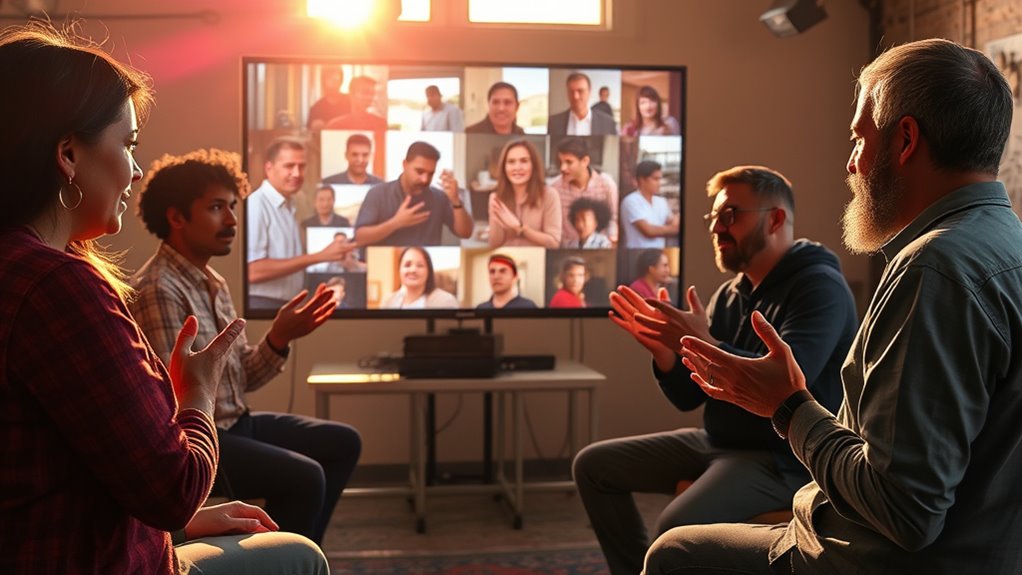Deaf filmmakers are transforming storytelling by creating authentic portrayals of Deaf culture and experiences. They challenge stereotypes and emphasize genuine representation through their work, often using visual and cultural details to enhance authenticity. Supporting Deaf-led projects and inclusive casting guarantees you see real Deaf voices and stories. If you want to learn more about how these filmmakers influence the industry and promote understanding, keep exploring the impactful work being done.
Key Takeaways
- Deaf filmmakers like Jules Dameron prioritize cultural integrity to ensure authentic Deaf storytelling.
- They challenge stereotypes by emphasizing Deaf culture, talent, and lived experiences in their work.
- Utilizing visualization techniques and accessible production methods enhances the authenticity of Deaf narratives.
- Supporting Deaf-led projects through funding and festivals promotes genuine representation and visibility.
- Incorporating Deaf voices in all production aspects fosters accurate portrayals and broad societal understanding.
The Importance of Authentic Deaf Representation in Film

Authentic Deaf representation in film is crucial because it guarantees that Deaf culture and experiences are portrayed accurately and respectfully. When Deaf filmmakers, actors, and content creators lead storytelling, it ensures authentic Deaf representation that reflects true cultural nuances and sign language use. Incorporating visualization techniques can help Deaf creators manifest more opportunities and visibility in the industry. Additionally, supporting inclusive casting promotes genuine representation and helps break down stereotypes. Media often misrepresents Deaf individuals when hearing actors play Deaf characters, making inclusion of Deaf talent essential. Authentic storytelling by Deaf creators highlights Deaf culture and fosters understanding among broader audiences. Films like *CODA* and *Children of a Lesser God* demonstrate how genuine Deaf representation can positively impact viewers. Emphasizing cultural authenticity in storytelling safeguards the integrity of Deaf narratives and promotes broader societal acceptance. Furthermore, utilizing diverse design options in film production can enhance the visual storytelling and authenticity of Deaf experiences. Embracing Deaf-led productions also encourages the development of unique narratives rooted in true Deaf perspectives, enriching the diversity of stories told in cinema.
Pioneering Deaf Filmmakers and Their Impact

Deaf filmmakers like Jules Dameron are transforming the industry by actively advocating for authentic Deaf storytelling and representation. They challenge Hollywood to move beyond stereotypes by highlighting Deaf talent and Deaf culture through their work. A focus on cultural integrity ensures that Deaf stories are told with respect and accuracy, fostering a genuine understanding of Deaf experiences. Emphasizing craft and textiles in their storytelling techniques allows Deaf filmmakers to incorporate visual elements that enhance the authenticity of their narratives.
Celebrated Projects Showcasing Deaf Culture

Celebrated projects like *CODA* and *Sound of Metal* have brought Deaf culture into mainstream awareness by depicting genuine Deaf experiences. These films prioritize Deaf representation, highlighting authentic Deaf stories through Deaf actors and culturally accurate portrayals. Understanding the importance of Deaf-led projects ensures that Deaf voices remain central in storytelling. Authentic Deaf storytelling emphasizes the significance of cultural accuracy and community involvement in creating impactful narratives. *CODA*’s Best Picture win underscores the significance of Deaf actors in delivering compelling performances rooted in Deaf culture. The success of these projects demonstrates how Deaf-led initiatives can elevate Deaf voices and foster greater understanding. Additionally, incorporating cultural authenticity in filmmaking helps combat stereotypes and promotes a deeper appreciation of Deaf communities. Recognizing the investment in Deaf talent is essential for producing films that truly represent Deaf experiences and foster inclusion in the industry. Moreover, understanding the potential pitfalls in adopting new payment technologies can be crucial for supporting the infrastructure needed to sustain and promote Deaf-led media projects.
Overcoming Challenges in Deaf-Centered Storytelling

| Challenge | Solution |
|---|---|
| Industry biases | Advocacy and awareness |
| Funding and resources | Community support and crowdfunding |
| Accessible production | Technical innovation |
A new sentence with Pimple Patch technology and the rest of the sentence.
How to Support and Promote Genuine Deaf Media

Supporting and promoting genuine Deaf media requires active engagement and intentional actions. To do so, consider these steps:
- Share and promote authentic Deaf stories by supporting Deaf filmmakers’ projects, crowdfunding campaigns, and festival screenings, boosting visibility. Engaging with inclusive casting and hiring practices can also ensure that Deaf talent is prioritized both in front of and behind the camera, promoting real Deaf representation.
- Advocate for inclusive casting and hiring practices that prioritize Deaf talent both in front of and behind the camera, ensuring real Deaf representation. Incorporating media and entertainment technology, such as AI-powered tools, can further enhance the accessibility and impact of Deaf media content.
- Attend Deaf film festivals like Deaf Rochester and Deaf Spotlight, and amplify Deaf creators’ work on social media through likes, comments, and shares to expand their reach. These actions help challenge stereotypes, foster cultural understanding, and support supporting Deaf creators.
Frequently Asked Questions
What Is Deaf Storytelling?
Deaf storytelling is about sharing stories that genuinely reflect Deaf culture, experiences, and perspectives. You use sign language and visual techniques to express emotions and cultural nuances that resonate with Deaf audiences.
It highlights themes like identity, community, and overcoming challenges. By creating authentic stories, you challenge stereotypes and give a true voice to Deaf experiences, fostering understanding and representation in media and beyond.
How Are Deaf People Portrayed in Movies?
You see that in many movies, Deaf characters are often played by hearing actors, which can lead to misrepresentation and stereotypes. Sometimes, sign language is used accurately, but often it’s exaggerated or minimal.
Films made by Deaf filmmakers tend to show Deaf people more authentically, with better cultural understanding.
How Does the Media Portray Deaf People?
You often see the media misrepresenting Deaf people by casting hearing actors in Deaf roles, which leads to inauthentic portrayals.
Deaf characters are frequently shown through stereotypes, focusing only on communication struggles or defining them solely by their deafness.
Media rarely depicts Deaf individuals as complex, fully fleshed-out people.
Instead, they serve as plot devices or comic relief, overlooking genuine Deaf culture and the importance of authentic storytelling.
Why Does Deaf Representation Matter?
You might think representation doesn’t matter, but it truly shapes how society sees Deaf communities.
When you see authentic Deaf stories, you’re better able to understand and appreciate their culture, challenges, and strengths.
It’s not just about inclusion—it’s about giving Deaf people a voice and identity.
Authentic portrayals challenge stereotypes, inspire confidence, and help preserve Deaf language and traditions for future generations.
Conclusion
By supporting authentic deaf storytelling, you help amplify voices that deserve to be heard. Every film made with genuine representation is a beacon, shining a light on unseen worlds. When you embrace these stories, you’re not just watching; you’re fostering understanding and breaking barriers. Remember, true representation isn’t just about inclusion—it’s about honoring the richness of Deaf culture. Together, you hold the power to turn silence into a chorus of understanding.











